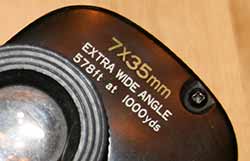
What do the numbers mean on Binoculars
Have you ever wondered what the numbers mean on binoculars, or what makes one binocular better than another, or why one binocular is better than another for a boat but terrible for astronomy. These pages are a result of my trying to figure all this out.
I was wondering also why the huge price difference between cheap binoculars and more expensive ones.

First, What do the Numbers Mean?
Binoculars at their most basic are made of 2 lens. An ocular, the small one by your eye, and an objective, the bigger one that you point at the object you want to see.
The Objective gathers the image in the form of light while the ocular magnifies the image and sends it to your eyes.
The first number refers to the amount of magnification. The bigger the number the greater the magnification. So a 7 x 50 binocular magnifies an image 7 times so that when you look in the eyepiece you see the object as though it were 1/7 of the distance it actually is.
The second number refers to the size of the objective in mm. In this case the objective is 50 mm across. The larger the objective the more light can get in the binoculars and the brighter the image will appear. This is usually not very relevant if you only plan to use your binoculars during the day, but if you will be viewing at night then it is very important. That is why astronomy instruments are large, to gather the most light possible.
In this particular binocular, there is a third number, 7.1. This is the field of view, the actual angle you see. It's a slice of 360 degrees which would be a complete view all around if that was possible. It is the same as saying 373 feet at 1000 yards.

Sometimes the field of view explained by giving feet over 1000 yards. This refers to how wide a diameter you can see at 1000 yards. To get the angle in degrees, just divide the number of feet, in this case 578 by 52.5 to get a bit more than 11 degrees.
The top binocular is the pair I use for watching the sky and looking for comets and other wonders. The 50 mm means it gives me quite a lot of light. The bottom pair is not so bright but has a very useful wide view, I use it for birdwatching. It's easier to keep the little rascals in sight when the angle of view is larger.
As I continue my research I will post the topic as I figure them out. I've added a page of definitions of terms for binoculars. Choosing the Right Binoculars, more info on technical properties and different types of binoculars.
email me if you find mistakes, I'll fix them and we'll all benefit: Christine
Binoculars
Terms and Definitions of words you will run across when you research binoculars.
This is the pair of binoculars I use in the boat. It has been really useful and the fact that it is waterproof means I don't worry about getting it wet. The image is clear, bright and the shape of the binoculars is lovely to hold. It is not stabilized and that would be a very nice feature but adds quite a lot to the price.
How it's made video from youtube. Making binoculars
Small Print
I don't claim to be an expert in anything. I'm just curious and like to research things. These pages are a result of my notes. I can make mistakes. Please let me know if you find one and I'll correct it.